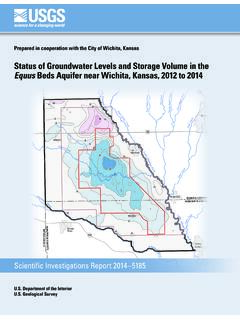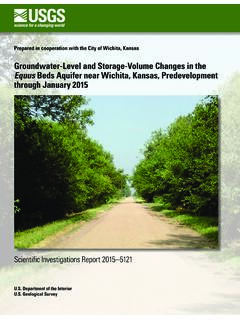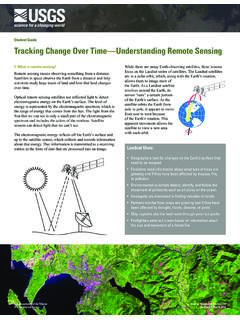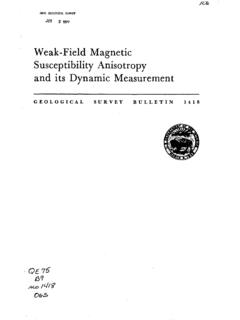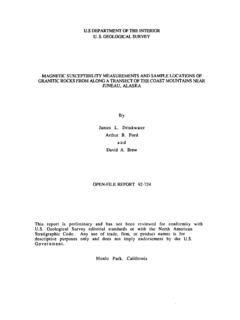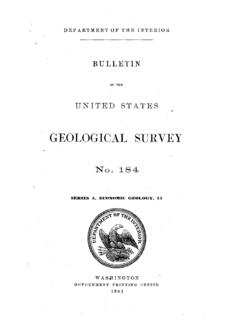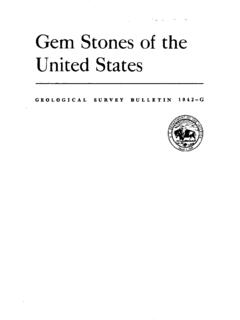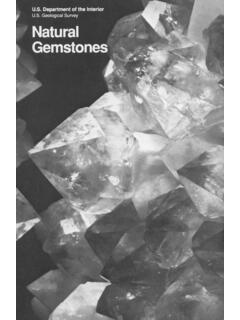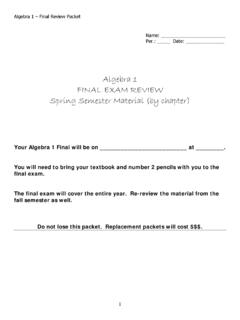Transcription of Chart of Conversion Factors - USGS
1 Chart of Conversion FactorsFrom English to Metric System and Metric to English SystemK P \ Geological Survey/Conservation DivisionUSGS: INF-76-16 Chart of Conversion FactorsPrefaceApproximate Conversions ' ' Theconversioh Factors in the following tables are for Conversion of our customary (English) units of measurement toSI*units,and for convenience, reciprocals are shown for converting SI units back to the English system. The first table contains rule-of-thumb figures, useful for "getting the feel" of SI units or mental estimation. The succeeding tables contain Factors accurate to 3 or more significant figures.
2 Please refer to known ^reference volumes for additional accuracy, as well as for Factors dealing yvith other scientific notationiinvolving SI * International System of Units multiply A x B To Get D(2) multiply D x C To Get Ainch (in)foot (ft)yard (yd)mile (mi) -' nautical milesquare inch (in2) :square foot (ft2)acre (43560 ft2)gallon (US)barrel (42 gal) ..ounce (oz) , (pound (Ib av)short ton (2,000 Ib)pound (mass)/foot (Ib/ft)Example (1):Convert 6 inches to centimeters6(A) x (B) = 15 cm (D) ' ' (cm)meter(m)meter (m) .kilometer (km)kilometer (km)square centimeter (cm2)square meter (m2)hectare (ha) (10,000 m 2)liter (L)cubic meter (m3).)
3 Gram (g)kilogram (kg)metric ton (t) '>-kilogram/meterExample (2):Convert 10 centimeters to inches10(D) x (C) = 4 in (A) This same format is used throughout this metrication above Conversion Factors are derived from the following Factors :1 inch (in) = (exact) centimeters (cm) 1 liter (L) = 1,000 cubic centimeters (cm3) 1 pound (Ib) = kilograms (kg)Other Conversion Factorsof Units Commonly Used by the Conservation Division(Three or More Significant Figures)Lengthinch (in)foot (ft)yard (yd)rod (16fc ft)chain (66 ft)milemile (nautical) (cm)meter (m)- meter (m)meter (m)meter (m)kilometer (km)kilometer (km)cAreasquare inch (in2)square foot (ft2)square yard (yd2)acre (43560 ft2)square mile (mi2)section (640 acre) orsquare mile (mi2)Volume, Capacitycubic inch (in3)cubic foot (ft3)
4 Cubic yard (yd3)cubic mile (mi3) ;gallon X231 in 3)barrel (42' US gal)acre-footMass (Weight)ounce (av)poundton (US short)' ' , , , , , ' .. square centimeter (cm2)square meter (m2)square meter (m2)hectare (ha)square kilometer (km2)..hectare (ha)cubic centimeter (cm3)cubic meter (m3)cubic meter (m3)cubic kilometer (km3)liter (L)cubic meters (m3)cubic meters (m3) gram (g)kilogram (kg)ton (t)** 1 metric ton = 1,000 kilograms (kg)Mass/Lengthpound/ft (Ib/ft) ' ' (Density, Concentration) ;lpound/cubic ft (Ib/ft3) pound/gallon (US) pound/gallon (US)Volume/Time (Flow Rate)cubic ft/second (ftVs) cubic ft/min (ft3 /min) US gallon/minute barrel/day* 1 cubic decimeter (dm3) = 1 liter (L), exactly.
5 Heat, Calorific (kg/m) ' . '' ~; meter (kg/m3) kilogram /cubic meter (kg/m3) gram'/cubic centimeter;(g/crn3)cubic decimeter/sec "(difiVs)* cubic decimeter/sec, (dmV's) .cubic .decimeter/sec (dmVs) cubic* decimeter/sec (dmVs)British thermal unit(60 F) (Btu) Calorie (20 C) (J) joule (J)Heat, Calorific Value-ContinuedBrit? ther. unit/lb(Btu/lb) . * - Brit, ther, unit/gal(Btu/gal) 'Brit. ther. unit/cubicfoot (Btu/ft3) -Gas Oil Ratiocubic foot/barrel (ftVbbl) . inch (psi) ' pound/square inch (psi) (kJ/kg) kilojoule/cubic meter (kJ/m3) kilojoule/cubic meter (kJ/m3)cubic meter/cubic meter (mVm3)kilogram/square centimeter (kg/cm2) kilopascal (kPa)**1 kilopascal (kPa) = 1 newton per square meter (N/m2) TemperatureTo convert temperature in Farenheit to "Celsius, subtract 32 and divide -by To.
6 Convert temperature in Celsius to "Fahrenheit, multiply by and add SI practice, number notation is made by separating digits into groups of three on either side of a decimal point, with a space or half space between groups. American Petroleum Institute publications Factors in this manner, written as a number between one and ten with six or less decimal places. The number is followed by E (for exponent), a plus or minus symbol, and two digits which indicatet the power of 10 by which the number must be multiplied to obtain the correct value. For example, 856 E+, 03 is 856 x 10 3 or 4 In writing, SI prefixes should be used to denote order of magnitude, as a substitute for writing powers of 10.
7 Following is a Chart of SI prefixes:Multiplication FactorsPrefixSI Symbol- ' Y ooo ooo ooo ooo = io i21 000 000 000 = IO91 000 000 = IO 6- , 1 000 = IO 3100 = IO 210 = 10' = = 1C'2 ' " = ' 000 001 = 000 000 001 = 'ooo ooo ooo 001 = 000 000 000 000 001 = IO*18teragigamega .kilohecto*deka*deci*cent!*milli micronanopicofemtoattoTGMkhdadcmjjnPf -a*To be avoided where GOVERNMENT PRINTING OFFICE: 1976-211-345/94
